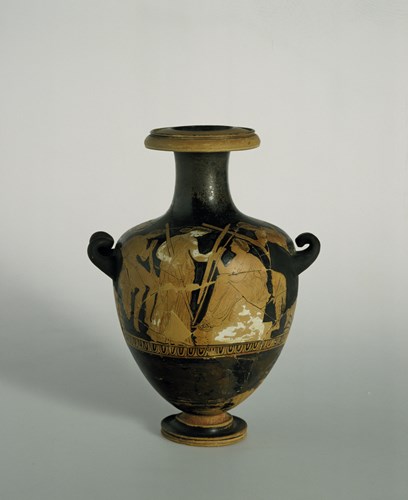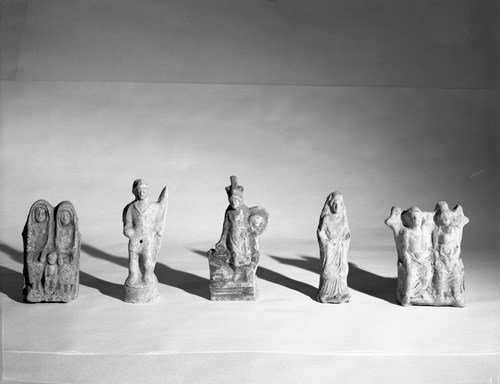Iakchagogos, Daeirites, Daeirites priestess
The Iakchagogos belongs to the auxiliary positions of the Eleusinian cult. His primary mission was to accompany the god Iacchus to Eleusis. The statue of the god remained in a sanctuary located near the Dipylon Gate, the main entrance to the city of Athens. On the morning of the 19th of Boedromion, the priests of Demeter passed by the sanctuary of Iacchus with the sacred objects of the goddess. They removed the statue of Iacchus to place it in a carriage at the head of the grand procession to Eleusis. The god was a personification of the procession’s sacred cry and was later identified with Dionysus. He was depicted holding a torch and participating in the procession crowned with myrtle.

Demeter seated on altar (?) with sceptre, Persephone with torches, Herakles, Iacchos with torches, 400-300 BCE, vessel, National Archaeological Museum © Hellenic Ministry of Culture and Sports/ Hellenic Organization of Cultural Resources Development
The Iakchagogos carried or accompanied the statue. The office was for life, and its holder probably came from the genos of the Eumolpidae. We know the name of only one Iakchagogos, Dionysios from the municipality of Marathon, so it seems that he didn't need to be an Eleusinian. Among the honours he enjoyed was a seat in the Theatre of Dionysus.

Demeter and Kore with Iacchos [Object Number 1932.56.57], sculpture, Harvard Art Museums © President and Fellows of Harvard College
The Daeirites priest and the Daeirites priestess must have been relatively low on the scale of the offices of Eleusinian worship because they are rarely mentioned, and it is not entirely clear how they relate to the Greater Mysteries. Pausanias mentions Daeira as the daughter of Oceanus and Tethys, the wife of Hermes and the mother of the eponymous hero Eleusis. No trace of her cult was found in the excavations at Eleusis, and it seems that even the ancients did not know much about her. The sources are terribly confusing regarding the role of the goddess as they consider her synonymous with Persephone (Aeschylus) or Pluto's guardian or sister and guardian of Kore during her stay in the Underworld. There are also reports about her hatred of Demeter. The priestesses of the goddess of agriculture did not participate in the sacrifices in honour of Daeira and did not partake of the victims.






